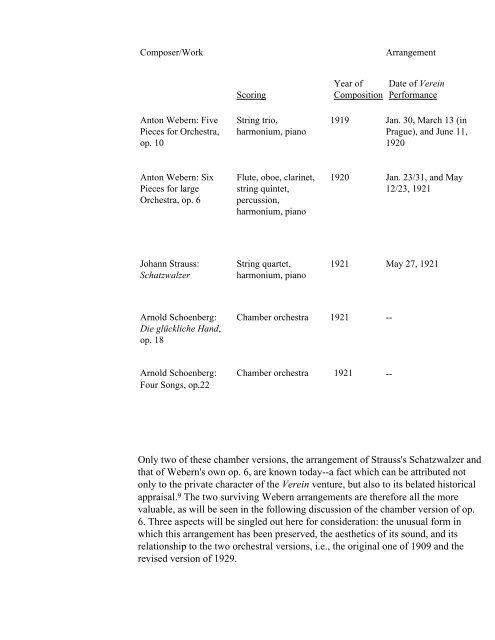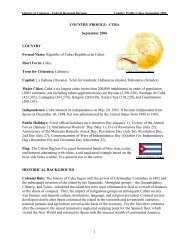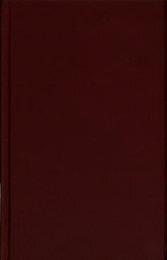Anton Webern's Six Pieces for Ocrhestra, op. 6, Arrangement for ...
Anton Webern's Six Pieces for Ocrhestra, op. 6, Arrangement for ...
Anton Webern's Six Pieces for Ocrhestra, op. 6, Arrangement for ...
You also want an ePaper? Increase the reach of your titles
YUMPU automatically turns print PDFs into web optimized ePapers that Google loves.
Composer/Work <strong>Arrangement</strong><br />
<strong>Anton</strong> Webern: Five<br />
<strong>Pieces</strong> <strong>for</strong> Orchestra,<br />
<strong>op</strong>. 10<br />
Scoring<br />
String trio,<br />
harmonium, piano<br />
Year of<br />
Composition<br />
Date of Verein<br />
Per<strong>for</strong>mance<br />
1919 Jan. 30, March 13 (in<br />
Prague), and June 11,<br />
1920<br />
<strong>Anton</strong> Webern: <strong>Six</strong> Flute, oboe, clarinet, 1920 Jan. 23/31, and May<br />
<strong>Pieces</strong> <strong>for</strong> large string quintet, 12/23, 1921<br />
Orchestra, <strong>op</strong>. 6 percussion,<br />
harmonium, piano<br />
Johann Strauss: String quartet, 1921 May 27, 1921<br />
Schatzwalzer harmonium, piano<br />
Arnold Schoenberg: Chamber orchestra 1921 -<br />
Die glückliche Hand,<br />
<strong>op</strong>. 18<br />
Arnold Schoenberg: Chamber orchestra 1921 -<br />
Four Songs, <strong>op</strong>.22<br />
Only two of these chamber versions, the arrangement of Strauss's Schatzwalzer and<br />
that of <strong>Webern's</strong> own <strong>op</strong>. 6, are known today--a fact which can be attributed not<br />
only to the private character of the Verein venture, but also to its belated historical<br />
appraisal. 9 The two surviving Webern arrangements are there<strong>for</strong>e all the more<br />
valuable, as will be seen in the following discussion of the chamber version of <strong>op</strong>.<br />
6. Three aspects will be singled out here <strong>for</strong> consideration: the unusual <strong>for</strong>m in<br />
which this arrangement has been preserved, the aesthetics of its sound, and its<br />
relationship to the two orchestral versions, i.e., the original one of 1909 and the<br />
revised version of 1929.



![Albert Einstein Papers [finding aid]. Library of Congress. [PDF ...](https://img.yumpu.com/21604228/1/190x245/albert-einstein-papers-finding-aid-library-of-congress-pdf-.jpg?quality=85)





![American Colony in Jerusalem Collection [finding aid]. Library of ...](https://img.yumpu.com/17941275/1/190x245/american-colony-in-jerusalem-collection-finding-aid-library-of-.jpg?quality=85)



![Piccard Family Papers [finding aid]. - American Memory - Library of ...](https://img.yumpu.com/17941234/1/190x245/piccard-family-papers-finding-aid-american-memory-library-of-.jpg?quality=85)


